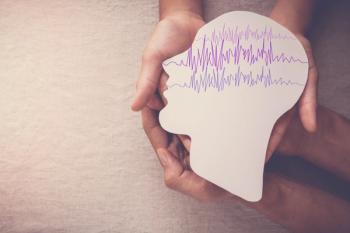
- Consultant for Pediatricians Vol 7 No 11
- Volume 7
- Issue 11
Happy 4-Year-Old Girl With Developmental Delays, Hand Flapping
This 4-year-old girl was born to a 27-year-old gravida, 1 para 0 mother at 37 weeks' gestation via vaginal delivery. The pregnancy was uncomplicated. Apgar scores were 8 at 1 minute and 9 at 5 minutes. The child's birth weight, head circumference, and length were 3045 g, 33 cm, and 50 cm, respectively. Her mother noted global developmental delays (particularly in the areas of speech and fine motor skills), abnormal sleep habits, obstructive sleep apnea, and seizure disorder. Family history was unremarkable.
Figure – This 4-year-old girl has a relatively small head, deep-set ears, a protruding tongue, and a wide mouth-all characteristic features of Angelman syndrome. In addition- although not visible in this photograph-she has intermittent exotropia, a flat occiput, widespaced teeth, and drooling.
Figure
HISTORY
This 4-year-old girl was born to a 27-year-old gravida, 1 para 0 mother at 37 weeks' gestation via vaginal delivery. The pregnancy was uncomplicated. Apgar scores were 8 at 1 minute and 9 at 5 minutes. The child's birth weight, head circumference, and length were 3045 g, 33 cm, and 50 cm, respectively. Her mother noted global developmental delays (particularly in the areas of speech and fine motor skills), abnormal sleep habits, obstructive sleep apnea, and seizure disorder. Family history was unremarkable.
PHYSICAL EXAMINATION
Her weight, height, and head circumference were 18 kg (90th percentile), 100 cm (50th percentile), and 48.5 cm (25th percentile), respectively. The child appeared quite happy. She had deep-set eyes, a posteriorly flattened head, intermittent left exotropia, occasional hand flapping, and tremors of her upper extremities. Deep tendon reflexes were 2+ and symmetrical bilaterally, with a downgoing plantar reflex. Results of the remainder of the physical examination were unremarkable.
STUDY RESULTS
An electroencephalogram (EEG) showed diffuse slow (2 to 3 Hz), high-voltage delta waves and moderate posterior discharges.
WHAT'S YOUR DIAGNOSIS?
ANSWER: ANGELMAN SYNDROME
Colloquially referred to as "happy puppet" syndrome or marionette joyeuse, Angelman syndrome was first described by Harry Angelman in 1965.1 Characteristic features of this syndrome include unusual facial characteristics, an especially happy demeanor, severe global developmental delays (particularly in language), seizures, and a jerky, marionettelike spasticity.2 Along with its sister condition, Prader-Willi syndrome, Angelman syndrome is commonly cited as a prime example of the effects of abnormal parental genomic imprinting.3,4
The incidence of Angelman syndrome ranges from 1 per 10,000 to 1 per 40,000 live births.2,5,6 Males and females are equally affected with no geographical clustering noted. There is controversy over whether a slightly increased incidence is associated with use of assisted reproductive technology-a result of the epigenetic dysregulation potentially caused by the process.7,8
ETIOLOGY
Angelman syndrome results from a defective maternally derived copy of the ubiquitin protein ligase E3A (UBE3A) gene located at chromosome 15q11.2-q13.8 UBE3A is subject to genomic imprinting and is mainly expressed from the maternal allele within the brain.8UBE3A defects occur through 4 known mechanisms, each of which is associated with a slightly different phenotype:
- Class I: interstitial deletions of maternal DNA from 15q11.2-q13 (70% of cases).
- Class II: uniparental disomy of paternal chromosome 15 (2% to 7% of cases).
- Class III: genomic imprinting malfunctions (2% to 5% of cases).
- Class IV: direct mutations of the maternal UBE3A gene (8% to 11% of cases).8-11
In addition, 10% to 20% of patients with an Angelman phenotype display no genetic abnormalities and hence have an unknown mechanism; these patients are said to have class V Angelman syndrome.2,8
Class I defects tend to produce the most severe phenotypes, while class II and class III defects usually produce phenotypes with more atypical features.2,9 Recurrence risks also vary with the underlying genetic defect.2,12 In this patient, fluorescent in situ hybridization (FISH) identified a 15q11.2-q13 deletion (a class I defect), with no evidence of genetic abnormalities in the mother. This result suggests that a de novo mutation occurred-the most common manner in which class I Angelman syndrome arises.13
Interestingly, while Angelman syndrome results from defects in maternally derived DNA at chromosome 15q11.2-q13, Prader-Willi syndrome, by contrast, results from defects in paternally derived DNA in the same region.4
CLINICAL MANIFESTATIONS
According to consensus diagnostic criteria published in 2005, the clinical manifestations of Angelman syndrome are divided into 3 prevalence-based categories. 14 The first category consists of features that are seen in all patients. These include severe developmental delay; behavioral changes (hypermotor behavior, easily elicited excitement, laughter, smiling, uplifting, and hand flapping); speech impairments, with minimal use of verbal language; and lastly, movement disorders ("puppet-like" tremulous movement of limbs with hypertonicity) and/or balance disorders (usually ataxia).14 In the second category are frequently seen features, which occur in more than 80% of patients. These include microcephaly, seizures, and abnormal EEG patterns.14
In the third category are associated features that are seen in 20% to 80% of patients with Angelman syndrome. Features in this category include characteristic facial appearance (flat occiput, occipital groove, protruding tongue, tongue thrusting, wide mouth with widespaced teeth and frequent drooling), feeding problems, strabismus, increased heat sensitivity, abnormal sleep-wake cycles (reduced total and REM sleep time, frequent nocturnal awakenings, leg movements without excessive daytime sleepiness), feeding difficulties, and abnormal fixations with water and "crinkly" items.14,15
COMPLICATIONS
Many complications of Angelman syndrome result from the progression of clinical features that first manifest in childhood.2 As affected children grow, gastroesophageal reflux and obesity develop; tremors and facial characteristics also become more pronounced (more pointed chin, macrostomia, deeper-set eyes, marked mandibular prognathism).14,16,17 Reduced mobility, joint contractures, and thoracic scoliosis often become issues in adulthood because of hypertonicity.14,16
Frequent epileptic seizures develop in about 80% to 90% of children.11,17 Osteopenia has also been noted,possibly as an adverse effect of long-term use of antiepileptic medications.18
Behaviorally, patients tend to sleep more regularly and become less excitable with age, although aggression and frustration increase because of continued communication difficulties that significantly impair quality of life. Danger perception and activities of daily living continue to be challenges; thus, patients generally require ongoing supervision and are unable to live independently. The life span is not greatly reduced.2
DIFFERENTIAL DIAGNOSIS
Clinical suspicion of Angelman syndrome tends to arise around age 3 years, when the characteristic behavioral changes predominate over the nonspecific neurological signs seen in infancy (such as microcephaly, flat occiput, protruding tongue, seizures).5,15 Before this age, mild and moderate cases tend to remain undiagnosed. 19 Conditions with which Angelman syndrome is commonly confused are loosely organized as follows:
- Single-gene conditions (Rett syndrome, Gurrieri syndrome, and N5, N10-methylenetetrahydrofolate reductase deficiency).
- Symptom complexes (cerebral palsy, Lennox-Gastaut syndrome, autism spectrum disorder, pervasive developmental delays, and encephalopathy).
- Microdeletions/duplications of chromosome regions 2, 4, 15, 17, and 22.11,12,20
DIAGNOSTIC STUDIES
Angelman syndrome is characterized by an abnormal childhood EEG with the following possible changes:
- Rhythmic 2- to 3-Hz triphasic delta waves accentuated over anterior regions and superimposed by interictal epileptiform discharges (most commonly observed).
- Persistent, rhythmic 4- to 6-Hz activity not associated with drowsiness.
- High-amplitude 3- to 4-Hz spike and sharp waves in posterior regions, elicited by eye closure.21
These EEG changes are highly specific to Angelman syndrome and can be helpful for diagnosis in the context of clinical features consistent with the condition.22 There are no significant differences between the EEGs of affected patients who suffer from seizures/epilepsy and the EEGs of those who do not. EEG changes tend to become less pronounced by age 9 years.13
The diagnosis of Angelman syndrome can also be confirmed with genetic testing according to a specific diagnostic algorithm involving DNA methylation testing, FISH and UBE3A mutation testing; however, normal results do not exclude the condition, because of the potential for class V defects.2,12
CT/MRI scans and results of blood, metabolite, and urine tests are usually unremarkable.5
TREATMENT
Because no known cure for Angelman syndrome exists, management goals are to improve the quality of life by relieving active symptoms and preventing disease progression. A multidisciplinary team approach is encouraged to manage the various aspects of the syndrome. 2 Early special education programs are vital since communication difficulties are often the most disabling feature of this syndrome.2 Involvement of a pediatric neurologist is often required because seizures can be especially difficult to control in early childhood. Valproate, clonazepam, phenytoin, and lamotrigine have been shown to be effective antiepileptic drugs.23 In adult patients, physiotherapy and occasionally orthopedic surgery may be needed to manage contractures. Finally, because a variety of genetic mechanisms can underlie Angelman syndrome, medical geneticists and genetic counselors play an important role in organizing genetic testing and educating patients and parents about recurrence risks.12 This patient's management team included a general pediatrician, a developmental pediatrician, a pediatric neurologist, a pediatric pulmonologist, a pediatric ophthalmologist, a geneticist, a physiotherapist, and a speech therapist.
References:
1.
Angelman H. "Puppet children": a report on three cases.
Dev Med Child Neurol.
1965;7:681-688.
2.
Clayton-Smith J, Laan L. Angelman syndrome: a review of the clinical and genetic aspects.
J Med Genet.
2003;40:87-95.
3.
Oliver C, Horsler K, Berg K, et al. Genomic imprinting and the expression of affect in Angelman syndrome: what's in the smile?
J Child Psychol Psychiatry.
2007;48:571-579.
4.
Cassidy SB, Dykens E, Williams CA. Prader-Willi and Angelman syndromes: sister imprinted disorders.
Am J Med Genet.
2000;97:136-146.
5.
Williams CA. Neurological aspects of Angelman syndrome.
Brain Dev.
2005; 27:88-94.
6.
Buckley RH, Dinno N, Weber P. Angelman syndrome: are the estimates too low?
Am J Med Genet.
1998;80:385-390.
7.
Arnaud P, Feil R. Epigenetic deregulation of genomic imprinting in human disorders and following assisted reproduction.
Birth Defects Res C Embryo Today.
2005;75:81-97.
8.
Lalande M, Calciano MA. Molecular epigenetics of Angelman syndrome.
Cell Mol Life Sci
. 2007;64:947-960.
9.
Lossie AC, Whitney MM, Amidon D, et al. Distinct phenotypes distinguish the molecular classes of Angelman syndrome.
J Med Genet
. 2001;38:834-845.
10.
Jiang Y, Lev-Lehman E, Bressler J, et al. Genetics of Angelman syndrome.
Am J Hum Genet.
1999;65:1-6.
11.
Williams CA, Lossie A, Driscoll D; RC Phillips Unit. Angelman syndrome: mimicking conditions and phenotypes.
Am J Med Genet.
2001;101:59-64.
12.
Stalker HJ, Williams CA. Genetic counseling in Angelman syndrome: the challenges of multiple causes.
Am J Med Genet.
1998;77:54-59.
13.
Galván-Manso M, Campistol J, Conill J, Sanmartà FX. Analysis of the characteristics of epilepsy in 37 patients with the molecular diagnosis of Angelman syndrome.
Epileptic Disord.
2005;7:19-25.
14.
Williams CA, Beaudet AL, Clayton-Smith J, et al. Angelman syndrome 2005: updated consensus diagnostic criteria.
Am J Med Genet A.
2006;140:413-418.
15.
Berry RJ, Leitner RP, Clarke AR, Einfeld SL. Behavioral aspects of Angelman syndrome: a case control study.
Am J Med Genet A.
2005;132:8-12.
16.
Laan LA, den Boer AT, Hennekam RC, et al. Angelman syndrome in adulthood.
Am J Med Genet.
1996;66:356-360.
17.
Laan LA, Renier WO, Arts WF, et al. Evolution of epilepsy and EEG findings in Angelman syndrome.
Epilepsia.
1997;38:195-199.
18.
Coppola G, Verrotti A, Mainolfi C, et al. Bone mineral density in angelman syndrome.
Pediatr Neurol
. 2007;37:411-416.
19.
Paprocka J, Jamroz E, Szwed-Bialozyt B, et al. Angelman syndrome revisited.
Neurologist.
2007;13:305-312.
20.
Jedele KB. The overlapping spectrum of rett and angelman syndromes: a clinical review.
Semin Pediatr Neurol.
2007;14:108-117.
21.
Laan LA, Vein AA. Angelman syndrome: is there a characteristic EEG?
Brain Dev
. 2005;27:80-87.
22.
Valente KD, Andrade JQ, Grossmann RM, et al. Angelman syndrome: difficulties in EEG pattern recognition and possible misinterpretations.
Epilepsia.
2003;44:1051-1063.
23.
Dion MH, Novotny EJ Jr, Carmant L, et al. Lamotrigine therapy of epilepsy with Angelman's syndrome.
Epilepsia.
2007;48:593-596.
Articles in this issue
about 17 years ago
Scalp Psoriasis in a 13-Year-Old Girlabout 17 years ago
Differentiating Epileptic Seizures From Nonepileptic Spellsabout 17 years ago
Polycystic Ovary Syndromeabout 17 years ago
Cystic Hygroma in an 11-Year-Old Girlabout 17 years ago
Simple Interventions Can Reduce Medication Errorsabout 17 years ago
An Honor for Our Own Dr Leungabout 17 years ago
Vaccines, the Public Trust, and the Importance of the Medical Homeabout 17 years ago
Generalized Lentiginosisabout 17 years ago
Pseudostrabismus (Pseudoesotropia)Newsletter
Access practical, evidence-based guidance to support better care for our youngest patients. Join our email list for the latest clinical updates.








